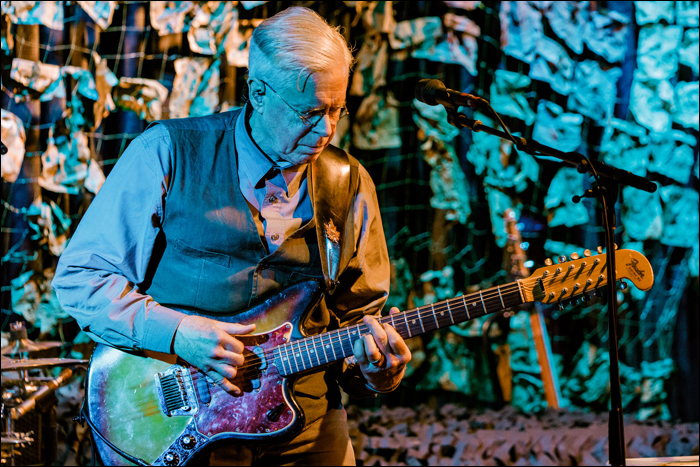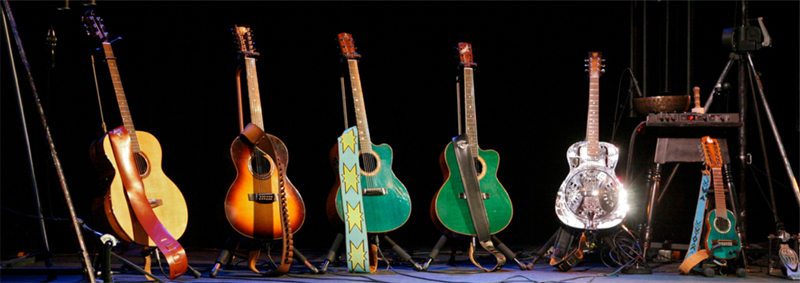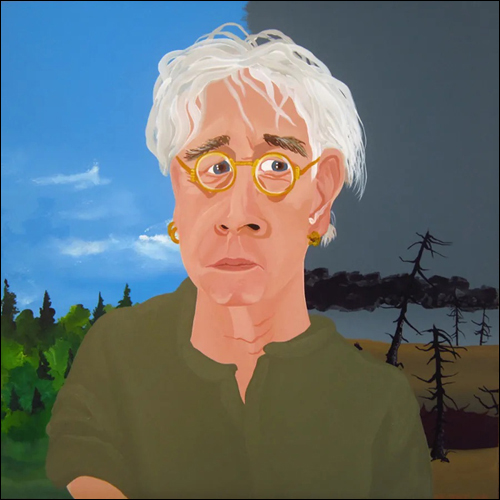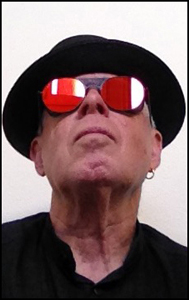by Adam Perlmutter – PremierGuitar.com
19 December 2017 –
“I see the way the music unfolds as a kind of architecture,” says Bruce Cockburn. “There’s a sense of visual shape that goes with how a melody moves.”
After Bruce Cockburn released his self-titled debut album in 1970, the prolific Canadian singer-songwriter released at least one album every couple of years, yielding a body of work that would be covered by everyone from Chet Atkins to Michael Hedges to Jerry Garcia. But following his 32nd album, 2011’s Small Source of Comfort, things appeared to suddenly dry out.
Cockburn hadn’t disappeared but had transferred his creative energies from songwriting to penning a memoir. In Rumours of Glory, published in 2014, Cockburn shares his personal and political life—he’s a longtime activist who has spoken out on human-rights violations and ecological devastation, among other things—and offers insights into his most popular songs, like “Wondering Where the Lions Are” (from 1979’s Dancing in the Dragon’s Jaws) and “If I Had a Rocket Launcher” (on 1984’s Stealing Fire).
The period he spent working on the memoir also coincided with the birth of a daughter, and between the demands of fatherhood and writing, Cockburn didn’t feel he had any new songs to offer. In fact, after the book was completed, he wondered if his work as a songwriter was ending, too.
But then Cockburn was asked to contribute a song for the 2015 documentary film Al Purdy Was Here, a portrait of the late Canadian poet, and other new songs soon followed. These tunes are collected on Bone On Bone, which Cockburn recorded with his core band of bassist John Dymond and drummer Gary Craig, along with his nephew John Aaron Cockburn on accordion, and jazz trumpeter Ron Miles on flugelhorn.
Cockburn now lives in the United States, and, lyrically speaking, Bone On Bone is a product of life in the Trump era. Musically speaking, it’s a product of Delta blues, modal jazz, and non-Western influences—all distilled in the guitarist’s idiosyncratic fingerstyle approach, with its intricate counterpoint.
Calling from his home in San Francisco, the 72-year-old Cockburn discussed his return to songwriting, shared one of his secret guitar tunings, and explained why his Manzer instruments have been his longtime companions.
“Putting music to a set of lyrics is like scoring a film. You have words that need to be served by the music.”
After completing your memoir Rumours of Glory, you decided you wouldn’t go back to writing songs. Why did you change your mind?
It wasn’t really a firm decision. I just wasn’t sure about returning to songs, because it’d been such a long time since I’d written anything of that sort. The creative energy that went into the book is what would’ve gone into songs if I hadn’t been writing a memoir. Also, I started the book when my second daughter, who’s now 5 years old, was born. Not only was I having to embark on this completely new kind of writing enterprise, but also I was getting no sleep because of the baby. All of that just conspired to make an absence of songs. After the book was put to bed, I thought, it’s been a long time since I wrote songs, maybe I’m supposed to be doing something else now or maybe not. It was just wait and see. Then, during that waiting and seeing, I was hoping song ideas would come. Luckily, they did.
Did you learn anything about your songwriting in the process of working on the book?
I don’t think I learned anything I didn’t already know. It was in some ways instructive to go back over all that old ground, but all along I’ve had a pretty good handle on how my writing process works. It’s been this wait-and-see thing ever since 1970, when I tried being a disciplined writer for a year and that didn’t really work for me. This is in the book—I ended up with about the same amount of usable material at the end of the year of diligently writing every day as I would have if I had just waited for good ideas. Mostly what I was writing was just throwaway stuff. After that, I didn’t bother anymore, I just waited.
The Canadian fingerpicker’s 33rd album features his nephew John Aaron Cockburn on accordion and jazz trumpeter Ron Miles on flugelhorn, and was produced by longtime collaborator Colin Linden.
The opening song on Bone On Bone is called “States I’m In,” and overall the album seems to have kind of an anxious energy. Does the current political situation here in the U.S. factor into the writing?
In an indirect way, it definitely does, as it does for all of us. Who gets through a day without saying the name Trump? You can’t these days. It’s just ridiculous, the degree that his showmanship is able to keep us paying attention to the stupid things he does. In that sense, it’s definitely part of “States I’m In,” it’s part of “Café Society” … any of the things that have exterior references in them, pretty much. The political atmosphere certainly colors the songs.
On “Bone On Bone,” you’ve got an interesting concept going on—a combination of McCoy Tyner-sounding chords and blues fingerpicking moves. How did you arrive at that synthesis?
It’s a good question. I date myself every time I do that, because I’m a product of that period [modal jazz of the 1960s] very much. I went to Berklee for a couple years, studying jazz composition. Coming out of high school, that’s what I thought I was going to be doing with my life. Being surrounded by people who were dedicated to music and by the sound of their music 24/7 for a couple years was really great, and many influences came into my music because of that.
I’d already had a great interest in jazz, and I was a big fan of Coltrane and all that stuff. At the same time, I was listening to Mississippi John Hurt and Big Bill Broonzy and all the older bluesmen, trying to fingerpick like them, which I never really learned how to do. In the process, I ended up mixing a kind of mutant fingerpicking with a lot of the jazz elements that I was learning.
At first, I was self-conscious about the jazz thing. I didn’t want to invite comparison with actual jazz guitars, because I didn’t think my playing warranted that. I’m not that great an improviser and have never been any good at playing on changes and stuff like that. So I didn’t include jazz in my own musical thinking for a long time. It crept in little by little. By the mid ’70s, I had enough confidence to bring in actual jazz musicians to play with me in the studio, and to some extent live. Then it grew from there.
Cockburn favors a tuning he calls EGAD. “It’s like DADGAD,” he explains, “but with the 6th string kept at E instead of lowered a step. I like how easy it is to get that McCoy Tyner movement under your fingers in that tuning.”
Throughout the album, the guitar parts tend to be less based on progressions than riffs.
I think that observation is exactly right. It’s also a product of the fact that when I was at Berklee in the ’60s, I was learning jazz harmonies and how to write horn charts using lots of IIm–Vs and all that stuff. I never related to it very well. I loved listening to the music people made that’s constructed that way, but it felt alien to me to try to make my own music like that.
At the same time, as I was being taught those things, the jazz world was discovering Indian and Arabic music, which don’t have any chords per se. They have harmonic relationships, but they’re relationships based on the shapes that melodies take against drones, even if the drones are sometimes imagined.
That music attracted me hugely. Then at the same time, the free-jazz thing came along, and I liked that a whole lot. I just found I was drawn to music that didn’t depend so much on chord changes, and partly—maybe it was laziness—I just didn’t have it in me to do the work to learn how to play with the standard kinds of chords. To some extent I’m envious of people who are really good at that, because it’s a wonderful skill, and it’d be nice to be able to do that.
I see the way the music unfolds as a kind of architecture. Maybe it’s from looking at meters in the studio or something. Especially the modern ones that are graph-like. There’s a sense of visual shape that goes with how a melody moves. That governs me more than the idea of chords. There have been times when I’ve experimented with that more. Certain songs and certain sets of lyrics seem to warrant more chord changes.
I tend to write a lot of lyrics that don’t seem to want that, that just want a rhythm, some kind of non-chordal support from the guitar. Putting music to a set of lyrics is like scoring a film. You have words that need to be served by the music. They need support, and they don’t want to be overwhelmed by it. You want to create a space, an auditory framework for the words to sit in, and that’s what the music’s all about.
Getting back to “Bone On Bone,” it sounds like you’re playing in an alternate tuning.
Yes. “Bone On Bone” is in a tuning I call EGAD—like DADGAD, but with the 6th string kept at E instead of lowered a step. It gives you all those fourths, but in E minor. I like how easy it is to get that McCoy Tyner movement under your fingers in that tuning. It took a bit of doing—for my brain at least—so I could play relatively freely over the droning bass in EGAD. It gives you some obvious handy things, but it also takes away some things that you’re used to from standard tuning.
Guitars:
Linda Manzer 6-string cutaway (2)
Linda Manzer 12-string
Linda Manzer electric charango
1930s S.S. Stewart archtop with Bartolini Hi-A pickup
Roundneck single-cone Dobro with brass body and biscuit bridge, Telecaster neck pickup, and internally mounted Shure SM58 microphone
Fender XII
Amps: 1960s Fender Vibrolux Reverb (2)
Electric Effects:
Boss TU-2 tuner
ZVEX Distortron
Empress Tremolo2
Boss DD-5 Digital Delay (2)
TC Electronic Corona Chorus
Acoustic Effects:
Boss DD-7 Digital Delay
Line 6 DL4
TC Electronic Hall of Fame Reverb
Strings and Picks:
Martin Marquis M2100 (6-string)
D’Addario EJ38 (12-string)
“In a perfect world, all my music would be totally improvisational. Perhaps that’s an illustration of the gap between how I actually do things in my daydreams and in reality.”
Early on in my career, I resisted using very many alternate tunings. I was kind of put off by how a lot of singer-songwriters were using open tunings. They basically changed the guitar tuning and didn’t learn any new fingerings—they’d get into different keys or different harmonic relationships just because of the tunings. It seemed like a cop-out to me.
That said, I learned open-C tuning from listening to Reverend Gary Davis, as well as the standard open-D tuning that everybody knows, stuff like that. I’ve never learned to play freely in the C tuning. There’s just not enough there for me to get into. It works great for certain things. I used it, for instance, on an older album [1991’s Nothing But A Burning Light], doing a cover of Blind Willie Johnson’s “Soul of a Man,” because there’s certain things that are there with that open-C tuning that are good bluesy things to do. It has a power to it.
For composed pieces, open C works quite well, as long as you have time to think about what you’re going to do. Improvising in it is hard, other than in that very basic blues way, for me. With the EGAD thing, it’s just a matter of playing on it a lot. You learn what to expect from where your fingers are going next. You can study it, obviously, too. You could write it all down and do it in a systematic way. That might be preferable for all I know, but for me, the process has been just learning it by doing.
Speaking of improvisation, how does that feature into your work as a singer/songwriter, especially on Bone On Bone?
Where possible, I like improvising. Often, I find a place for a guitar solo in a song—two verses and a guitar solo and another verse—or some structure like that, where the opportunity to solo is written in. And the length of the solo can vary. Like on “If I Had a Rocket Launcher,” I’m just playing over an Em chord, basically.
There’s plenty of improvisation on the new album. I gave myself a shot at improvising crude blues riffs on “Café Society” and the opportunity to jam on States I’m In,” although the song probably could’ve done without it. The song would still work, but I like the idea of having it in there. “Mon Chemin” starts with an improvised bit before the other instruments come in.
The trumpet/flugelhorn player Ron Miles improvises all through the album. He’s a jazz guy, an amazing improviser, much more so than you can tell from what he does on my album, though he did contribute greatly to it. With musicians of that caliber, you can just let them show up to the session and then turn them loose on the recording. This kind of improvisational process is usually how I operate with bands—people coming up with their own parts.
In a perfect world, all my music would be totally improvisational. Perhaps that’s an illustration of the gap between how I actually do things in my daydreams and in reality. I write in a pretty structured way. Any song can be improvised on, but the songs don’t always invite it, let’s say. This album has a lot that did. Perhaps this is one of the things that distinguishes it from some of my other stuff.

So the arrangements came together in the studio, as you presented the songs to the musicians?
Basically, yep. It was a multiple-way conversation between [producer] Colin Linden, me, and the musicians. In the case of John Dymond and Gary Craig, we’ve worked together a lot in different settings over the years, and Colin and I have done a lot of stuff together for 20 years now. Communication’s very, very easy. There’s a sense of what to expect from each other. It makes for a short conversation.
If you bring in somebody new, like Ron or my nephew John Aaron [Cockburn], who plays accordion on the album, there’s more to talk about and more to sort out, because they’re coming from a place of unfamiliarity with the setting. Still, if people know what they’re doing, it’s usually pretty easy to get good results.
It’s kind of uncommon for singer-songwriters to pair acoustic guitar with flugelhorn and accordion. Did you decide on the instrumentation first, and then look for players, or was it the other way around?
It was the former, actually. I have a friend named Myra Melford, a really great jazz pianist who lives in Oakland. We knew we were going to record in the Bay Area, and I knew I wanted a trumpet player who would be a good foil for me. Myra recommended Ron Miles.
Then there’s the case of my nephew. I knew he played accordion and guitar—he’s a very gifted young musician. He has a band of his own that leans toward Eastern European-influenced stuff. I hadn’t heard him play anything but that. I wondered what would happen. I thought, I know he can play the instrument, and I know he’s really musical, so let’s check it out. He came through in spades and is in the touring band now, too.
It’s working really well. It’s circumstantial, but it can go any which way. I’ve had experiences of the other kind, where I know somebody or I just run into somebody, they happen to be in town, and it’s like, let’s get them on the record. But this album didn’t really have that.
Was it difficult to blend acoustic guitar with flugelhorn, given how much more powerful the horn is?
I think in general, horns probably are easier to make a pretty sound with electric guitar, but it can all work. It’s a matter of finding the right kind of parts and the right musical relationship between instruments. In theory, any instrument can go with any instrument, really. Acoustically, you can get into a problem when you have very loud and very soft together. If I’m playing acoustic guitar unamplified with a clarinet player or even a piano player, I’m going to get drowned out.
But with today’s technology, that kind of difference in the instruments’ power doesn’t really matter. It’s more like, is this particular trumpet player’s tone going to harmonize with or blend well with my guitar? You think about those things, but for me, the bigger consideration is what kind of stuff they’re going to play. That said, Ron brought the flugelhorn, because it has that slightly mellower tone than the trumpet. I thought it fit really well with the sounds we were getting in the studio.
What guitars did you play on the album?
It varied from song to song. On “Bone On Bone”— the only instrumental on the album —I played a guitar that belonged to Colin Linden. That’s a Gibson L-7C, I believe, an old one. We were doing these overdubs at Colin’s studio in Nashville. He had all his guitars sitting around there, and I found that one to be the best one for that piece.
The dominant acoustic sound is the sound of Manzers. “States I’m In,” for instance, was recorded on my Manzer 6-string. I played my Dobro on “3 Al Purdys,” and there’s the solidbody electric charango that Linda Manzer made for me years ago, which is what you hear on “Mon Chemin,” the French song. Others are on my Manzer 12-string, such as “Looking And Waiting” and “Twelve Gates To The City.”
I had some other guitars around, but I didn’t use them much. “Café Society” is on an old S.S. Stewart archtop, which I have a pickup on. It’s one of the original Bartolini pickups for acoustic guitar, called a Hi-A, which I’ve had since the mid ’70s. It was superseded by pickups that sounded more acoustic, but I kept the pickup around because it’s a good one and it sounds great on the S.S. Stewart.

Tell us more about your Manzer instruments.
I’ve known Linda since the ’70s, actually, when she was apprenticing to Jean Larrivée. The first instrument she made for me was that little solidbody charango I mentioned, which she made in the late ’80s. Then a year or two later I got her to make me the 6-string that you hear on the record. The 12-string is a more recent acquisition, from the early 2000s. It’s an older guitar—Linda made it for somebody else, and it came back to her.
How are the Manzers different from other steel-strings for you? What’s made them your go-to guitars for so long?
Over the course of many years, I went through a lot of guitars, trying to find one that was just right. I got a Larrivée that I was told was the first cutaway he’d made. At that time, the search was on for something you could amplify. It’s one thing to be onstage playing solo into a microphone, but the minute you had any kind of a band, you needed more.
Pickups got better, and I had quite a few different commercial brands of acoustic-electric guitar. But I decided to go back to a handmade instrument, and that’s when I asked Linda to make me one. We talked about what characteristics it would have, but my input wasn’t terribly meaningful because I’ve never really paid that much attention to these things. I did ask for a little wider fretboard, thinking it might be nice to have the strings a bit further apart, for fingerpicking purposes. I also asked that the neck be shaped in such a way that I could get my thumb around it to fret notes on the lowest string, because I do that a lot.
That is the advantage of going to a luthier for a custom-made guitar—you can get exactly what you want in an instrument. That’s not to say you can’t find great guitars that were made in factories. There are so many wonderful Martins and Gibsons. Then, you have small companies making splendid guitars. I’ve got a Collings—a Brazilian rosewood and Adirondack spruce dreadnought—that’s a beautiful guitar. I bought it in the early ’90s from Westwood Music in L.A.
The truth is, there are so many great luthier- and factory-made guitars these days—so many more than when I was starting out in the ’70s. Though in the end, it matters less what you play than how you play it.
In this live version of If I Had a Rocket Launcher,” Cockburn fingerpicks his roundneck Dobro and dives into a chimey solo at 3:02.
Manzer cutaway in hand, Cockburn performs “States I’m In”—a standout track from Bone On Bone—live at CBC’s studios.
Credit: Bruce Cockburn: Just Wait and See – by Adam Perlmutter









